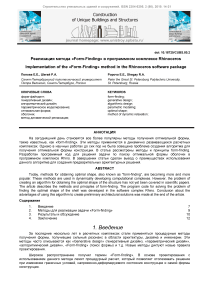Реализация метода "form-finding" в программном комплексе Rhinoceros
Автор: Попова Екатерина Евгеньевна, Шегай Роман Андреевич
Журнал: Строительство уникальных зданий и сооружений @unistroy
Статья в выпуске: 5 (80), 2019 года.
Бесплатный доступ
На сегодняшний день становятся все более популярны методы получения оптимальной формы, также известные, как «form-finding». Эти методы применяются в динамично развивающихся расчетных комплексах. Однако в научных работах до сих пор не была освещена проблема создания алгоритма для получения оптимальной формы конструкции. В статье рассмотрены методы и принципы form-finding. Разработан программный код для решения задачи по поиску оптимальной формы оболочки в программном комплексе Rhino. В завершении статьи сделан вывод о преимуществах использования данного алгоритма для создания предварительных архитектурных решений.
Форм-файндинг, генеративный дизайн, алгоритмический дизайн, параметрическое моделирование, оптимальная форма, оболочки, метод динамической релаксации
Короткий адрес: https://sciup.org/143170700
IDR: 143170700 | DOI: 10.18720/CUBS.80.2
Список литературы Реализация метода "form-finding" в программном комплексе Rhinoceros
- Design optimization [Электронный ресурс]. URL: https://medium.com/generative-design/design-optimization-2ec2ba3b40f7 (дата обращения 16.11.2018).
- Tuanjie L., Jiang J., Hanqing D., Zhanchao L., Zuowei W. Form-finding methods for deployable mesh reflector antennas // Chinese Journal of Aeronautics. №26(5). 2013. pp. 1276-1282.
- Pagitz M. Finite element based form-finding algorithm for tensegrity structures // International Journal of Solids and Structures. №17. 2009. pp. 3235-3240.
- Koohestani K. Form-finding of tensegrity structures via genetic algorithm // International Journal of Solids and Structures. №49 (5). 2012. pp. 739-747.
- Koohestani K., Guest S. A new approach to the analytical and numerical form-finding of tensegrity structures // International Journal of Solids and Structures. № 50 (19). 2013. pp. 2995-3007.
- Quagliaroli M., Malerba P. Flexible bridge decks suspended by cable nets. A constrained form finding approach // International Journal of Solids and Structures. №50. 2013. pp. 2340-2352.
- Lienhard J. Bending-active structures: form-finding strategies using elastic deformation in static and kinetic systems and the structural potentials therein. 2014. 116 p.
- Linn R., Espath L., Awruch A. Optimal shape of axisymmetric solids using NURBS and automatic differentiation // Applied Mathematical Modelling. №38. 2014. pp. 1385-1402.
- Philipp B., Wüchner R., Bletzinger K.-U. Advances in the Form-finding of Structural Membranes // Procedia Engineering. №115. 2016. pp. 332-341.
- Pagani P., Scott J. Curvature based sampling of curves and surfaces // Computer Aided Geometric Design. №59. 2018. pp. 32-48.
- Goldbach A.-K., Breitenberger M., Widhammer A., Bletzinger K.-U. Computational cutting pattern generation using isogeometric B-Rep analysis, // Procedia Engineering. №155. 2016. pp. 249-255.
- Haber, R.B., Abel, J.F. Initial equilibrium solution methods for cable reinforced membranes. Part I - Formulations // Computer Methods in Applied Mechanics and Engineering. 1982. №30. pp. 263-284.
- Bletzinger, K.-U., Ramm, E. A general finite element approach to the form finding of tensile structures by the updated reference strategy // International Journal of Space Structures 1999. №14. pp. 131-145.
- Pauletti, R.M.O., Pimenta, P.M. The natural force density method for the shape finding of taut structures // Computer Methods in Applied Mechanics and Engineering. 2008. №197. pp. 4419-4428
- Veenendaal D., Block P. An overview and comparison of structural form finding methods for general networks // International Journal of Solids and Structures. 2012. № 15. pp. 3741-3753.
- H.-J. Schek. The force density method for form finding and computation of general networks // Computer Methods in Applied Mechanics and Engineering. 1974. №3. pp. 115-134.
- Linkwitz, K. Combined use of computation techniques and models for the process of form finding for prestressed nets, grid shells and membranes // Proceedings of Internationalen Symposium Weitgespannte Flächentragwerke. 1976.
- Barnes, M.R. Form-finding and analysis of tension space structures by dynamic relaxation, Ph.D. thesis, City University London, United Kingdom. 1977.
- Lewis, W.J. Tension structures. Form and Behaviour. Thomas Telford, London, 2003. 210 p.
- Haug, E., Powell, G.H. Analytical shape finding for cable nets // Proceedings of the 1971 IASS Pacific Symposium Part II on Tension Structures and Space Frames. 1972. №1(5). pp. 83-92.
- Nouri-Baranger T. Computational methods for tension-loaded structures // Archives of Computational Methods in Engineering. 2004. №11. pp. 143-186.
- Baerlecken D., Manegold M., Reitz J., Kuentsler A. Integrative parametric form-finding processes // Proceedings of the 15th International Conference on Computer Aided Architectural Design Research in Asia, Hong Kong. 2010. pp. 303-312.
- Thomsen M., Tamke M., Deleuran. A. Hybrid tower, designing soft structures // Modelling Behaviour. 2015. pp. 87-99.
- Grohmann M., Bollinger K., Weilandt A., Wagner M. Form finding of the shell structures of the Rolex Learning Center in Lausanne // Proceedings of the International Association for Shell and Spatial Structures (IASS) Symposium/ 2009. pp. 654-665.
- Tessmann O., Schein M. Structural Analysis as Driver in Surface-Based Design Approaches // International journal of architectural computing. №1. 2008. pp. 19-40.
- Tessmann O. Collaborative Design Procedures for Architects and Engineers. Ph.D. thesis. Zürich. 2008.
- Lachauer L., Kotnik T. Curved Bridge Design // Computational Design Modelling. 2011. pp. 145-152.
- Lachauer L., Kotnik T. Interactive Parametric Tools for Structural Design. 2011.
- Mirtschin, J Engaging Generative BIM Workflows // Collaborative Design of Lightweight Structures. 2011.
- Jungjohann H., Woodington W. Ontario Celebration Zone Pavilion: A Large Pneumatic Structure // Procedia Engineering. №155. 2016. pp. 507-515.
- Hauke JungjohannHauke JungjohannWalter WoodingtonCoelho R., Tysmans T., Verwimp E. Form finding & structural optimization // Structural and Multidisciplinary Optimization. №49(6). 2013.
- Kilian A., Ochsendorf J. Particle-spring systems for structural form finding // Journal of the International Association for Shell and Spatial Structures. №46(148). 2005. pp. 77-84.
- Lienhard J. Bending-active structures: form-finding strategies using elastic deformation in static and kinetic systems and the structural potentials therein. 2014. 116 p.
- Barnes M. Form Finding and Analysis of Tension Structures by Dynamic Relaxation // International Journal of Space Structures. №14.2. 1999. pp. 89-104.
- Piker D. Kangaroo: Form Finding with Computational Physics // Architectural Design. № 83(2). 2013. pp. 136-137.
- Minimal Surface [Электронный ресурс]. URL: https://wewanttolearn.wordpress.com/2015/11/11/scherks-minimal-surface/ (дата обращения 21.11.2018).
- Attar R, Aish R., Stam J., Brinsmead D., Tessier A., Glueck M., Khan A. Physics - based generative design // CADD Future Conference. 2009. pp. 231-244.


